The Air Cushion Machine Market is estimated to be valued at USD 886.9 million in 2025 and is projected to reach USD 1372.8 million by 2035, registering a compound annual growth rate (CAGR) of 4.5% over the forecast period.
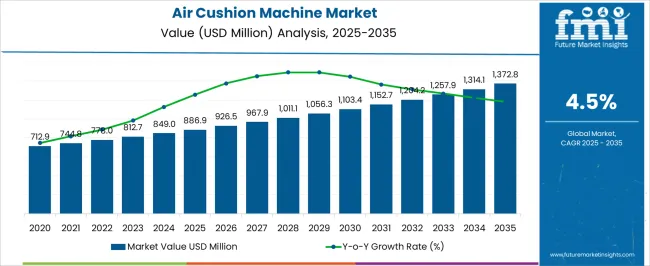
| Metric | Value |
|---|---|
| Air Cushion Machine Market Estimated Value in (2025 E) | USD 886.9 million |
| Air Cushion Machine Market Forecast Value in (2035 F) | USD 1372.8 million |
| Forecast CAGR (2025 to 2035) | 4.5% |
The air cushion machine market is experiencing sustained growth as industries increasingly focus on cost effective and sustainable packaging solutions. Rising e commerce activities and the surge in global trade are creating strong demand for protective packaging technologies that ensure safe product delivery while reducing material waste.
Air cushion machines provide on demand packaging that minimizes storage requirements and optimizes shipping efficiency, making them highly attractive for businesses aiming to streamline operations. Technological advancements such as automated systems and energy efficient models are further expanding their adoption across diverse sectors.
In addition, the shift toward recyclable and biodegradable air cushion films is supporting compliance with environmental regulations and corporate sustainability goals. The outlook for the market remains positive, with manufacturers emphasizing innovation, customizability, and integration with automated packaging lines to meet evolving industry needs.
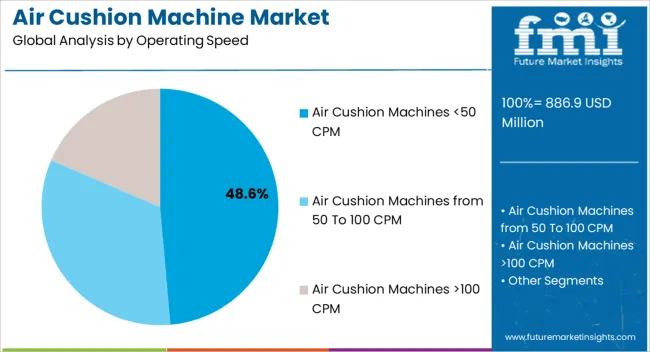
The air cushion machines operating at less than 50 CPM are projected to account for 48.60% of market revenue by 2025, making this the leading operating speed category. The growth of this segment is being driven by its suitability for small to medium scale operations, where flexibility, cost efficiency, and compact design are prioritized.
These machines require lower capital investment and are easier to install and maintain, which appeals to businesses with limited packaging volumes. Their ability to produce reliable protective packaging at a manageable pace has reinforced their presence among SMEs and niche industries.
The segment’s adoption is further supported by the increasing demand for customized packaging solutions that do not require large scale, high speed production capacity, thereby securing its leading position in the operating speed category.
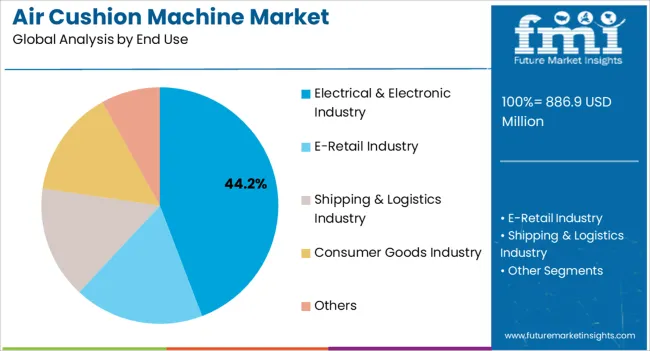
The electrical and electronic industry segment is anticipated to contribute 44.20% of market revenue by 2025, establishing it as the largest end use category. This dominance is attributed to the critical need for safe and efficient packaging of sensitive electronic components, which are highly susceptible to damage during storage and transportation.
Air cushion machines provide superior shock absorption, lightweight protection, and cost effective packaging solutions tailored for high value electronic goods. The growth of global consumer electronics, coupled with increased exports of semiconductors and electronic devices, has reinforced the reliance on air cushion packaging.
Additionally, compliance with strict safety and quality standards in the electronics industry has encouraged widespread adoption. As demand for advanced electronic products continues to expand, this end use segment is expected to remain at the forefront of air cushion machine utilization.
Increasing technological advancements in the packaging industry boost the growth of the air cushion machine market in the coming years. The increased demand for air cushions on the backdrop of their ability to protect the packed products drives the demand of the market.
Manufacturers of various end-use industries are focusing on strengthening their supply chain network, and protective packaging is playing an important role in the process, increasing the demand for air cushions and positively influencing the growth in the air cushion machine market. Being lightweight and compatible with production processes are some other factors boosting the growth in the air cushion machine market.
Although the air cushion machines market has numerous end-uses, numerous obstacles likely pose a challenge to market growth. The availability of other alternatives, like paper packaging, may hinder the growth of the air cushion machine market. The stringent government rules and regulations towards the use of plastic are expected to hamper the growth of the air cushion machine market in the forecasting year.
Also, the high cost of air cushion packaging is considered another restraining. In addition, the increasing use of substitutes for air cushions, such as molded fiber trays and foam, is further reducing the use of air cushions and may hinder the growth of the market.
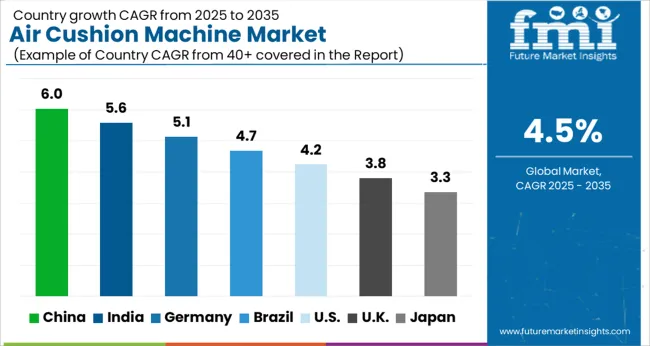
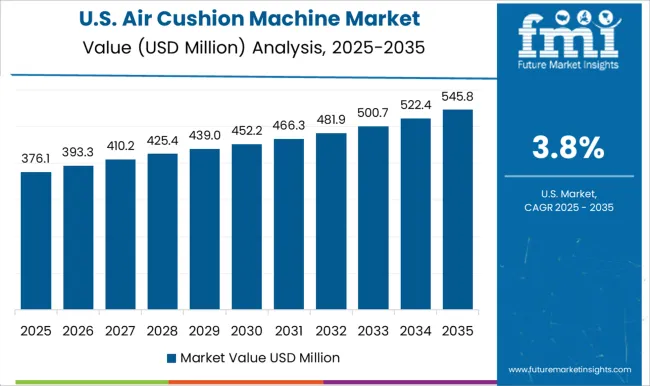
North America was the leading market for air cushion machines market, and the trend is expected to continue into the forecast period owing to the increasing disposable incomes and growing demand for consumer electronics in the region. The growing demand for air cushion machines for safe packaging purposes due to the increase in online shopping applications is expected to augment the market. As per Future Market Insight's analysis, the North American region is forecast to have a 35% total share of the market.
North America is expected to be the next dominant region, witnessing high adoption rates for the air cushion machine market during the forecast period. With a high concentration of manufacturing industries in North America, demand for the air cushion machines market is anticipated to rise.
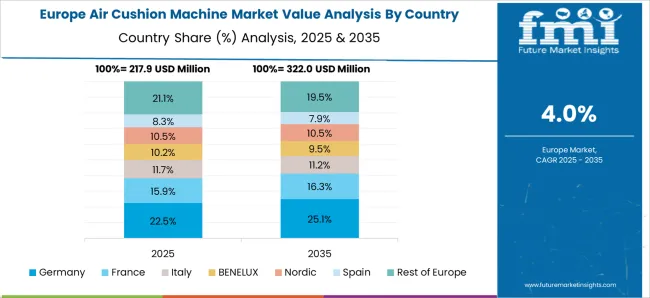
According to Future Market Insights, Europe is expected to provide immense growth opportunities for the air cushion machines market due to the growing e-consumer awareness in the region. The air cushion machines market is expected to witness sustained growth over the forecast period.
The European air cushion machines market accounts for the second-leading share of the global air cushion machine market, registering a 24% share. Advancements in packaging technology are fueling regional market growth. Increasing the use of online shopping applications directly increase the demand for air cushion packaging solution, which boost the growth of the market in the region.
In June 2024, United States-based packaging company Sealed Air invested more than USD 30 million in its Automated Packaging Systems (APS) brand to modernize and expand the capacity of its facilities. The investments see Sealed Air install ‘touchless’ automation and proprietary digital printing technologies at its APS facilities in Streetsboro and Bedford Heights, Ohio, and Keyser, West Virginia.
In March 2024, Kite Packaging Ltd expanded its product portfolio with a wide range of filler and wrapper cushions with air on demand and used 100% recyclable film. The range now comprises three unique systems, allowing customers to purchase a system specifically suited to the size and volumes.
In February 2024, German packaging firm Storopack unveiled a new paper cushion system for applications requiring high throughput and secure packaging material. The PAPERplus Track system provides paper cushions directly at the packing station, ensuring effective padding. PAPERplus Track can be used to package 5kg to 50kg products.
| Attribute | Details |
|---|---|
| Forecast Period | 2025 to 2035 |
| Historical Data Available for | 2020 to 2025 |
| Market Analysis | USD million for Value |
| Key Countries Covered | United States, Canada, Germany, United Kingdom, France, Italy, Spain, Russia, China, Japan, South Korea, India, Thailand, Malaysia, Indonesia, Australia, New Zealand, GCC Countries, Northern Africa, and South Africa |
| Key Segments Covered | Operating Speed, End Use, Region |
| Key Companies Profiled | Hangzhou Bing Jia Technology Co. Ltd.; Zhuhai E-One Science and Technology Co. Ltd.; D.J Hoogstraten; Shandong Xinyi Environmental Protection Technology Co. Ltd.; Airpack; Ameson Packaging; Focus Technology Co. Ltd.; Technology International; Sealed Air; AirPackagingMachine |
| Report Coverage | Market Forecast, Company Share Analysis, Competition Intelligence, DROT Analysis, Market Dynamics and Challenges, and Strategic Growth Initiatives |
| Customization & Pricing | Available upon Request |
The global air cushion machine market is estimated to be valued at USD 886.9 million in 2025.
The market size for the air cushion machine market is projected to reach USD 1,372.8 million by 2035.
The air cushion machine market is expected to grow at a 4.5% CAGR between 2025 and 2035.
The key product types in air cushion machine market are air cushion machines <50 cpm, air cushion machines from 50 to 100 cpm and air cushion machines >100 cpm.
In terms of end use, electrical & electronic industry segment to command 44.2% share in the air cushion machine market in 2025.






Full Research Suite comprises of:
Market outlook & trends analysis
Interviews & case studies
Strategic recommendations
Vendor profiles & capabilities analysis
5-year forecasts
8 regions and 60+ country-level data splits
Market segment data splits
12 months of continuous data updates
DELIVERED AS:
PDF EXCEL ONLINE
Market Leaders & Share in the Air Cushion Machine Industry
Airless Paint Spray System Market Size and Share Forecast Outlook 2025 to 2035
Air Caster Skids System Market Size and Share Forecast Outlook 2025 to 2035
Airborne Molecular Contamination Control Services Market Forecast and Outlook 2025 to 2035
Airflow Balancer Market Size and Share Forecast Outlook 2025 to 2035
Aircraft Cabin Environment Sensor Market Forecast and Outlook 2025 to 2035
Aircraft Flight Control System Market Size and Share Forecast Outlook 2025 to 2035
Airborne Radar Market Size and Share Forecast Outlook 2025 to 2035
Aircraft Electric Motor Market Forecast Outlook 2025 to 2035
Airport Ground Transportation Market Forecast and Outlook 2025 to 2035
Airless Sprayer Accessories Market Size and Share Forecast Outlook 2025 to 2035
Air Purge Valve Market Size and Share Forecast Outlook 2025 to 2035
Air Flow Sensors Market Size and Share Forecast Outlook 2025 to 2035
Air Separation Plant Market Size and Share Forecast Outlook 2025 to 2035
Air Cooled Turbo Generators Market Size and Share Forecast Outlook 2025 to 2035
Aircraft Cooling Turbines Market Size and Share Forecast Outlook 2025 to 2035
Air Conditioning Compressor Market Size and Share Forecast Outlook 2025 to 2035
Air Measuring Equipment Market Size and Share Forecast Outlook 2025 to 2035
Aircraft Smoke Detection and Fire Extinguishing System Market Size and Share Forecast Outlook 2025 to 2035
Aircraft Hose Fittings Market Size and Share Forecast Outlook 2025 to 2035

Thank you!
You will receive an email from our Business Development Manager. Please be sure to check your SPAM/JUNK folder too.
Chat With
MaRIA